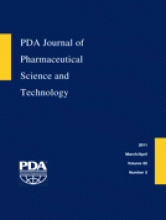Research ArticleResearch
The Importance of Accurate Microorganism Identification in Microbial Challenge Tests of Membrane Filters—Part I
I. Kaesler, G. Haake, H. Hennig, A. Rosenhagen, T. H. Meltzer and M. W. Jornitz
PDA Journal of Pharmaceutical Science and Technology March 2011, 65 (2) 92-99;
I. Kaesler
G. Haake
H. Hennig
A. Rosenhagen
T. H. Meltzer

References
- 1.↵
American Society for Testing and Materials (ASTM), Standard F838-05, Standard Test Method for Determining Bacterial Retention of Membrane Filters Utilized for Liquid Filtration; ASTM International: West Conshohocken, PA, 2005.
- 2.↵
U.S. Food and Drug Administration (FDA). Guidance for industry: sterile drug products produced by aseptic processing; Center for Drugs and Biologics and Office of Regulatory Affairs; Food and Drug Administration: Rockville, MD, 2004.
- 3.↵
Sterilizing filtration of liquids. Technical report no. 26. PDA J. Pharm. Sci. Technol. 2008, 52 (S1).
- 4.↵
- Sundaram S.,
- Auriemma M.,
- Howard G. Jr..,
- Brandwein H.,
- Leo F.
- 5.↵
- Sundaram S.,
- Eisenhuth J.,
- Howard G. Jr..,
- Brandwein H.
- 6.↵
- Sundaram S.,
- Eisenhuth J.,
- Steves M.,
- Howard G. Jr..,
- Brandwein H.
- 7.↵
- Sundaram S.,
- Eisenhuth J.,
- Lewis M.,
- Howard G. H. Jr..,
- Brandwein H.
- 8.↵
- Sundaram S.,
- Lewis M.,
- Eisenhuth J.,
- Howard G. Jr..,
- Larson B.
- 9.↵
- Lee A.,
- Hussong D.,
- Brorson K.
- 10.↵
- Lee A.,
- McVey J.,
- Faustino S.,
- Lute S.,
- Sweeney N.,
- Pawar V.,
- Khan M.,
- Brorson K.,
- Hussong D.
- 11.↵
- Benson D. A.,
- Karsch-Mizrachi I.,
- Lipman D. J.,
- Ostell J.,
- Wheeler D. L.
- 12.↵
- Ludwig W.,
- Strunk O.,
- Westram R.,
- Richter L.,
- Meier H.,
- Yadhukumar,
- Buchner A.,
- Lai T.,
- Steppi S.,
- Jobb G.,
- Förster W.,
- Brettske I.,
- Gerber S.,
- Ginhart A. W.,
- Gross O.,
- Grumann S.,
- Hermann S.,
- Jost R.,
- König A.,
- Liss T.,
- Lümann R.,
- May M.,
- Nonhoff B.,
- Reichel B.,
- Strehlow R.,
- Stamatakis A.,
- Stuckmann N.,
- Vilbig A.,
- Lenke M.,
- Ludwig T.,
- Bode A.,
- Schleifer K.-H.
- 13.↵
- Pruesse E.,
- Quast C.,
- Knittel K.,
- Fuchs B.,
- Ludwig W.,
- Peplies J.,
- Glöckner F. O.
- 14.↵
- Madsen R. E.,
- Akers J. E.,
- Jornitz M. W.,
- Meltzer T. H.
- 15.↵
- Ridgway H. F.,
- Rigby M. G.,
- Argo D. G.
- 16.↵
- Tolliver D. L.,
- Schroeder H. G.
- 17.↵
- Meltzer T. H.,
- Jornitz M. W.
- 18.↵
- Mittelman M. W.,
- Kawamura K.,
- Jornitz M. W.,
- Meltzer T. H.
- 19.↵
Validation of microbial retention of sterilizing filters. PDA/FDA Special Scientific Forum, Bethesda, MD, 1995.
- 20.↵
- Leahy T. J.,
- Sullivan M. J.
- 21.↵
- Ding L.,
- Yokota A.
- 22.
- 23.
- Hylemon P. B.,
- Wells J. S. Jr..,
- Krieg N. R.,
- Jannasch H.
- 24.
- Garrity G.
- Vancanneyt M.,
- Segers P.,
- Abraham W.,
- De Vos P.
- 25.
- Garrity G.
- Willems A.,
- Gillis M.
In This Issue
PDA Journal of Pharmaceutical Science and Technology
Vol. 65, Issue 2
March/April 2011
The Importance of Accurate Microorganism Identification in Microbial Challenge Tests of Membrane Filters—Part I
I. Kaesler, G. Haake, H. Hennig, A. Rosenhagen, T. H. Meltzer, M. W. Jornitz
PDA Journal of Pharmaceutical Science and Technology Mar 2011, 65 (2) 92-99;
Jump to section
Related Articles
- No related articles found.
Cited By...
- Benchmarking of Sterilizing-Grade Filter Membranes with Liposome Filtration
- The Importance of Accurate Microorganism Identification in Microbial Challenge Tests of Membrane Filters. Part II. The Comparison of Hydrogenophaga pseudoflava ATTC 33668 and Curvibacter sp. ATCC 700892 by Microbial Challenge Tests with Membrane Filters
- Sterilizing Filtration of Liposome and Related Lipid-Containing Solutions: Enhancing Successful Filter Qualification





